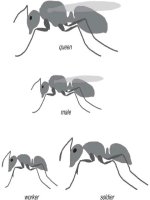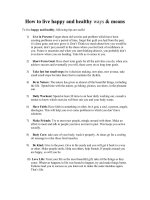dig it how to collect rocks and minerals
Bạn đang xem bản rút gọn của tài liệu. Xem và tải ngay bản đầy đủ của tài liệu tại đây (6.91 MB, 53 trang )
READER’S DIGEST
Explorer Guides
How to Collect
Rocks and Minerals
●
P
R
O
J
E
C
T
S
●
F
U
N
F
A
C
T
SHow to Collect
Rocks and Minerals
Written by Susan Tejada
Illustrated by Steve Seymour and Ed French
DIG IT!
How to Collect Rocks and Minerals
Electronic book published by ipicturebooks.com
24 W. 25th St.
New York, NY 10010
For more ebooks, visit us at:
All rights reserved.
Copyright
2001 Reader’s Digest Children’s Publishing, Inc.
Originally published by Reader’s Digest Children’s Books in 2001
No part of this book may be reproduced or transmitted in any form or by any means,
electronic or mechanical, including photocopying, recording, or by any information
storage and retrieval system, without permission in writing from the publisher.
e-ISBN 1-59019-633-3
Library of Congress Cataloging-in-Publication Data
Tejada, Susan Mondshein.
Dig it! : how to collect rocks and minerals / written by Susan Tejada ; illustrated by
Steve Seymour and Ed French.
p. cm.—(Reader’s Digest explorer guides)
Includes index.
1. Rocks—Collection and preservations—Juvenile literature. 2. Minerals—Collection
and preservation—Juvenile literature. [1. Rocks—Collection and preservation. 2.
Minerals—Collection and preservations.] I. Seymour, Steve, ill. II. Title. III. Series.
QE433.6.T44 2000
552´.0075—dc21 00-042538
Contents
Stories in Stone 5
Good Places to Collect 6
Gearing Up 8
Stay Safe 10
Earth, from the Inside Out 12
Dig Those Rocks 14
Don’t MIS This! 16
The Rock Cycle 18
Life with Rocks 20
Space Rocks 22
Dig Those Minerals 24
Search for Identity 26
Razzle-Dazzle 28
Living Gems 30
Strange and Unusual Minerals 32
Eat Your Minerals! 34
Dig Those Fossils 36
As Old As the Hills 38
A Fossil in a Haystack 40
A Piece of the Rock 42
Downtown Fossils 44
Old-Timers 46
Glossary 48
Index 50
Go forth, under the open sky, and list
To Nature’s teachings.
—William Cullen Bryant
Stories in Stone
Read any good rocks lately? Even though rocks don’t
contain words, they tell amazing stories. Did you know that
long ago huge reptiles swam in a sea that covered Kansas? Or
that feathered dinosaurs roamed a lakeshore in China? The
Sahara Desert was once underwater. Tropical forests grew in
Antarctica. How do we know? By reading rocks.
Today, people travel hundreds of miles to see beautiful
rocks shaped like arches, towers, and domes. Rock climbers
scramble up tall rocks like Devils Tower
in Wyoming. And rock hounds
everywhere collect rocks, minerals,
and fossils.
See for yourself how much fun
it is to be a rock hound. Collect
rocks near home or far away.
Start with the ones that come
with this book. Ready, rock
hounds? Let’s start exploring.
5
Good Places to Collect
There are lots of good places to look for rocks, minerals,
or fossils. Some of the best ones are:
• The beach at low tide
• At the bottom of steep hills or cliffs
• Along rivers and streams
• Quarries
• Outcrops (bare rock sticking up out of the ground)
• Road cuts (where roads were blasted through rock)
One great way to find out about good collecting spots
is to join a club for rock hounds. Ask a science teacher,
librarian, or someone who works in a natural history
museum for information about clubs.
6
SOME DOS AND DON’TS
• Ask for permission before you go on private property.
• Ask the owner if you can collect a few samples.
• Don’t remove samples from national parks—it’s
against the law.
• Don’t litter.
• Don’t disturb the animals.
• Don’t take too many samples.
Y
o
u
w
i
l
l
n
e
e
d
c
e
r
t
a
i
n
k
i
n
d
s
o
f
r
o
c
k
s
o
r
m
i
n
e
r
a
l
s
t
o
d
o
s
o
m
e
o
f
t
h
e
a
c
t
i
v
i
t
i
e
s
i
n
t
h
i
s
b
o
o
k
.
I
f
y
o
u
d
o
n
’
t
h
a
v
e
t
h
e
o
n
e
y
o
u
n
e
e
d
,
l
o
o
k
f
o
r
i
t
i
n
h
o
b
b
y,
n
a
t
u
r
e
,
o
r
m
u
s
e
u
m
s
h
o
p
s
.
7
Gearing Up
You don’t need tools to gather loose rocks. To collect
pieces of larger rocks, you can use a hammer and chisel to
break off samples. Carry your samples in a strong bag, such
as a backpack. To protect them, wrap each one in newspaper,
napkins, or paper towels. Store small samples in empty egg
cartons or small boxes. You can find most of these things
around your house—but always ask permission before taking
or using them.
Use your brush to clean your
samples. Paint a white spot on
each one and write a number on
it in permanent marker, then seal
with clear nail polish. In a notebook,
write down the number, then describe your sample.
J
u
l
y
1
7
H
a
m
i
l
t
o
n
C
l
i
f
f
s
s
a
n
d
s
t
o
n
e
b
r
e
c
c
i
a
m
i
g
m
a
t
i
t
e
s
l
a
t
e
8
As your rock collection grows, you’ll be able to remember
where and when you found each one.
You may also want to use:
• A field guide and magnifying glass to identify samples
• A map and compass to guide you on a collecting trip
• A sieve or strainer to sift out small samples
Hold Everything
Rock collectors need a place to keep their samples and show
them off. The easiest display box to make is from an egg carton
lined with cotton wool (see page 8). Here’s an idea for something
a little fancier.
What You’ll Need
A cardboard box, any size
Sheets of cardboard
Scissors
Cotton wool
What to Do
1. If the box is deep, cut it
down to make it more
shallow (ask for adult help).
2. Cut strips of cardboard
the same depth and
length as the box. Cut
more strips of cardboard
the same depth and width as the box.
3. Cut vertical slits along one edge of each strip, two to three
inches apart.
4. Fit the strips together in a grid pattern, using the slits as
notches.
5. Line the box with cotton wool, then place the cardboard grid
inside, on top of the cotton.
6. Add samples!
9
Stay Safe
You won’t be attacked by dinosaurs on a rock-collecting
trip, but you might meet up with other dangers. Follow these
tips for safe searching.
Don’t go exploring alone. Take a grownup and a friend
or two along. Tell someone else where you are going and
when you expect to return. If poisonous snakes live in the
area, make sure someone with you knows what to do in
case of snakebite.
When chipping at rocks, wear
goggles to protect your eyes from
flying fragments. Buy safety
goggles at a hardware store, or
use swimming goggles or a
snorkel mask.
Map
Water bottle
Watch
Brush
Waterproof shoes
10
Protect your head when you are working near cliffs or
steep hills. Wear a hard hat such as a bike helmet. Protect
your hands with sturdy work gloves and your feet with
waterproof boots or shoes. Wear long sleeves and pants
to protect your arms and
legs from scrapes, scratches,
and bug bites.
Take along water and
a snack. Rock hounds
need their energy! Wear a
watch to keep track of the
time. You will want to
return before it gets dark.
Goggles
Hammer
Work gloves
Bike helmet
Backpack
L
O
O
K
O
U
T
F
O
R
:
●
F
a
l
l
i
n
g
r
o
c
k
s
!
A
n
d
d
o
n
’
t
c
l
i
m
b
o
n
c
l
i
f
f
s
.
●
S
n
a
k
e
s
!
T
h
e
y
o
f
t
e
n
h
i
d
e
u
n
d
e
r
o
r
a
r
o
u
n
d
r
o
c
k
s
.
I
n
s
t
e
a
d
o
f
l
i
f
t
i
n
g
a
l
o
o
s
e
r
o
c
k
s
t
r
a
i
g
h
t
u
p
,
p
u
l
l
i
t
t
o
w
a
r
d
y
o
u
w
i
t
h
y
o
u
r
h
a
m
m
e
r
,
k
e
e
p
i
n
g
t
h
e
r
o
c
k
b
e
t
w
e
e
n
y
o
u
a
n
d
a
n
y
s
n
a
k
e
.
●
C
a
r
s
!
B
e
E
X
T
R
E
M
E
L
Y
c
a
r
e
f
u
l
i
f
y
o
u
’
r
e
c
o
l
l
e
c
t
i
n
g
a
l
o
n
g
t
h
e
s
i
d
e
o
f
a
r
o
a
d
.
●
D
e
e
p
,
d
a
r
k
p
l
a
c
e
s
!
D
o
n
’
t
g
o
i
n
t
o
c
a
v
e
s
o
r
d
o
w
n
o
l
d
m
i
n
e
s
h
a
f
t
s
.
11
Earth, from the Inside Out
If you think the ground under your feet is rock-solid,
think again. At the very center of Earth lies the core. The
superheated metal of the inner core is squeezed solid. But the
hot metal of the outer core is liquid. The inner mantle
surrounding Earth’s core is solid rock. The outer mantle has a
layer of partly melted rock. The thin, rocky layer that covers
the mantle is Earth’s crust. This is the ground we walk on as
well as the ocean floor.
Crust
Inner core
Outer core
Mantle
12
The crust is split up into
huge pieces, like the pieces of
a giant jigsaw puzzle. These
pieces, called plates, can
move up to a few inches a
year. Sometimes the plates
bump into each other, and one
plate may slip underneath the
other. Sometimes a plate
cracks and produces a new
ocean. Over millions of years, the movements of the plates
change Earth’s appearance. Land rises and mountains form.
Land sinks and valleys appear. Volcanoes erupt and lava
hardens, building up new land.
Making Mountains
When Earth’s continents collide, pressure
pushes up the land at the edges of the
plates. Over millions of years, mountains
form. See how this works.
What You’ll Need
A paper plate
A piece of paper
Adhesive tape
Scissors
What to Do
1. Cut the plate in half. Each half represents one of Earth’s plates.
2. Tape the short ends of the paper to each plate half. The paper is
Earth’s crust.
3. Now push the plate halves together, sliding one half under the other.
4. What happens? Like the piece of paper, land is pushed up into
mountains, but over very long periods of time.
Two plates colliding
13
Dig Those Rocks
Some rocks are smooth and bright. Some rocks are rough and speckled.
Some rocks are shiny and hard.
Star
sapphire
Gabbro
Obsidian
Some rocks are dull and fibrous.
Hundreds of different
kinds of rocks exist, and
they’re everywhere. In fact,
rocks make up Earth itself.
But what makes up rocks?
Minerals. Some rocks are made
up of just one mineral. Marble,
for example, has only the
mineral calcite in it. Usually,
though, rocks contain several
minerals. The rock called granite
holds the minerals quartz, mica,
and feldspar.
Asbestos
14
Feldspar
Quartz
Mica
Granite
It’s a Gas!
Limestone contains the mineral
calcite. Find out what happens
when limestone comes into
contact with an acid.
What You’ll Need
Glass jar
4 tablespoons of white vinegar
Small piece of limestone
What to Do
1. Pour the vinegar into the jar.
2. Drop in the limestone.
3. What happens? Why does the limestone start to bubble?
Vinegar, an acid, dissolves the calcite. This releases
carbon dioxide gas—the same gas that puts the “pop” in
soda pop.
4. Try this activity outdoors. Carry some vinegar in a plastic
bottle and dribble a few drops on different rocks. If they
contain calcite, they’ll start to fizz. Then use a field guide
to find out what kind of rocks they are—limestone, chalk,
or marble.
ROCK HALL OF FAME
Biggest single rock:
Uluru (Ayers Rock), in
Australia, is more than 1,000
feet (345 m) tall and 5½ miles
(9 km) around.
Biggest rock construction:
The Great Wall of China is
1,500 miles (2,400 km) long.
Longest cave system:
Mammoth Cave, in Kentucky, is
about 300 miles (480 km) long.
15
Don’t MIS This!
That’s not a MIStake. “MIS” is a code to help you
remember the three kinds of rocks: metamorphic, igneous,
and sedimentary. These words describe how rocks form.
Geologists (people who study Earth and its rocks and
minerals) use them to identify all the rocks in the world.
Metamorphic rocks form inside Earth’s crust. There, great
heat and pressure work on the minerals that make up rocks. As
that happens, rocks metamorphose, or change, into other kinds
of rocks. One type of rock may even change in different ways.
Shale, for example, can change into slate, schist, or gneiss
(pronounced “nice”).
When a volcano erupts, melted rock rises up from inside
Earth. This rock is called magma. When it reaches the surface,
magma is called lava. As magma and lava cool, they harden
and become igneous rock such as granite or basalt.
Metamorphic Igneous Sedimentary
Layered Look
When pieces of rock fall into
water, the largest ones reach
the bottom first. Try this
activity and see for yourself!
What You’ll Need
1 small scoop of soil
1 small scoop of gravel
Clear jar with a lid
Water
What to Do
1. Put the soil and gravel in the jar and cover them
with water.
2. Screw the lid on tightly and shake the jar to mix
the contents.
3. Set the jar on a shelf for a day or two.
4. What happens? The largest, heaviest pieces will
be at the bottom. The smallest, lightest pieces
will be at the top.
Weather and water break up the rocks on Earth’s surface.
Streams and rivers carry the pieces into lakes and seas. There,
they settle to the bottom. Over millions of years, pieces
harden into rock layers. When the water level drops, the layers
become dry land. This kind of rock is called sedimentary
rock. Sandstone, shale, and limestone are different types of
sedimentary rocks.
The Rock Cycle
The rock cycle takes millions of years. It has been going
on since Earth began. And it is going on now, while you are
reading this book.
Melted rock from deep inside Earth comes to the surface.
It cools and hardens, becoming igneous rock. Rock falls,
water, ice, and changes in temperature slowly break the rock
into smaller and smaller pieces. Water, glaciers, and wind
carry the pieces from one place to another. Slowly, these
pieces of rock build up into layers of sedimentary rock.
Over time, the sedimentary rock gets deeply buried in
Earth’s crust. There, heat and pressure turn it into
metamorphic rock. The metamorphic rock melts and the
entire cycle begins again.
Water and ice
break rock into
pieces.
Rock partially
melted by
pressure and
radioactivity
cools and
hardens.
Hot, liquid rock
erupts onto Earth’s
surface.
Bits and pieces of
rock are washed into
the ocean.
18
LOSING YOUR MARBLES
Artists like to make statues out of marble.
Why? Because it’s beautiful and strong. But
when the statues are outside, rain—which
contains some acid—slowly wears away the
marble. Acid rain, a kind of pollution, has
even more acid in it. Take a look at the
marble statues in your town. Do they have
worn-down noses, ears, or fingers? These
are signs of acid damage.
Breaking Up
The cycle of freezing and thawing
can break up even solid things as
tough as rock. Try this project to
see how it works.
What You’ll Need
Modeling clay
Plastic wrap
Bowl of water
What to Do
1. Divide the clay into two equal pieces.
2. Dip each piece in the water, then shape it into a ball.
3. Wrap each clay ball in the plastic wrap. Put one in the
freezer and the other in the refrigerator. Leave overnight.
4. The next day, unwrap the balls. How are they different?
Does the frozen one have cracks in it? If not, wet it and freeze
it again.
Note: In the mountains, rock can freeze and thaw every day.
Why? Because even in warm weather, the temperature can drop
below freezing at night. Over thousands of years, this cycle can
completely change the way the land looks.
19
Life with Rocks
In ancient times, people used
flint (a kind of quartz) to make life
easier. They shaped pieces of flint
into sharp-edged axes, arrowheads,
and other tools. They used rocks to
make digging sticks, grindstones,
and battle-axes.
Of course you don’t live in ancient times. You live right
here and now. But people still use rocks and minerals every
day. Tall buildings are made of steel, concrete, and glass—all
materials that come from rocks. Steel is made from iron, coke
(a kind of coal), and limestone. Concrete is made with
limestone, sand or gravel, and water. Glass is made from sand.
Look around your house. Pots and
pans are made from minerals that
contain metals such as iron and
aluminum. Quartz crystals are used
in TV transmitters and to make silicon
chips for computers. Copper is used
for wires. Zinc and galena are used
in batteries. Sulfur is used in
fertilizers, plastics, and rubber.
The list of ways we use
rocks and minerals is
endless!
20
Old Paint
Long ago, people made paint from crushed rock mixed with liquid.
You can do it, too.
What You’ll Need
Cardboard Small bowl
Pebbles (small rocks) Water
Thin rag or old dish towel Soap flakes (or you can use
Hammer cornstarch or corn syrup)
Goggles
What to Do
1. Put a piece of cardboard on the sidewalk.
2. Put the pebbles on the cardboard.
Cover them with the rag to keep them from flying up.
3. Carefully hammer the pebbles to powder. Wear your
goggles while doing this.
4. Put the powder in a small bowl. Add just
enough water and soap to make a thin
paste. Presto—paint!
5. Use your paint to color
a design on a rock.
T
r
y
u
s
i
n
g
d
i
f
f
e
r
e
n
t
p
e
b
b
l
e
s
t
o
m
a
k
e
d
i
f
f
e
r
e
n
t
c
o
l
o
r
s
o
f
p
a
i
n
t
.
21
Space Rocks
On a clear night, you may see shooting stars in the sky.
But they’re not really stars, and they don’t all stay in the sky.
Shooting stars are really meteors. Most of them are caused by
parts of an asteroid—chunks of rock that circle the sun just
like the planets do. Millions of meteors are seen in Earth’s
atmosphere every day. But don’t worry! Most of these space
chunks are small and quickly burn up in the air. Only a few
actually land on Earth. Then they are called meteorites.
Almost all meteorites are made of rock. Most look very
much like Earth rocks. This makes them hard to find unless
you see them fall. Other meteorites are made of iron,
including all the giant meteorites people have ever found.
DEEP IMPACT
In Arizona, there’s a crater that’s 4,000 feet (about 1,200 m) wide and
600 feet (about 183 m) deep. How did it get there? It may have been a
huge meteorite that crashed into Earth 20,000 years ago. How huge?
Scientists now think it weighed about 63,000 tons (about 57,000 metric
tons)—heavier than 11,000 African elephants.
22
HEAVY METAL
Where did an isolated tribe of 19th century Eskimos get metal for
toolmaking? This puzzled experts for years, but explorer Robert Peary
finally found the answer in 1894—meteorites. A local guide helped
him find three of these large space rocks in northwest Greenland. It
took Peary years to dig out the largest meteorite, and when he finally
got the rock to New York City, it took a team of 28 horses to pull it
from the dock to the American Museum of Natural History! You can
see it there today.
W
H
I
C
H
I
S
W
H
I
C
H
?
A
s
t
e
r
o
i
d
s
a
r
e
l
a
r
g
e
c
h
u
n
k
s
o
f
r
o
c
k
t
h
a
t
c
i
r
c
l
e
t
h
e
s
u
n
.
A
m
e
t
e
o
r
o
i
d
i
s
u
s
u
a
l
l
y
a
p
i
e
c
e
o
f
a
n
a
s
t
e
r
o
i
d
t
h
a
t
h
a
s
b
r
o
k
e
n
o
f
f
.
W
h
e
n
a
m
e
t
e
o
r
o
i
d
e
n
t
e
r
s
E
a
r
t
h
’
s
a
t
m
o
s
p
h
e
r
e
,
w
e
c
a
l
l
t
h
e
s
t
r
e
a
k
o
f
l
i
g
h
t
i
t
m
a
k
e
s
a
m
e
t
e
o
r
.
W
h
e
n
a
m
e
t
e
o
r
o
i
d
l
a
n
d
s
o
n
E
a
r
t
h
,
w
e
c
a
l
l
i
t
a
m
e
t
e
o
r
i
t
e
.
23









